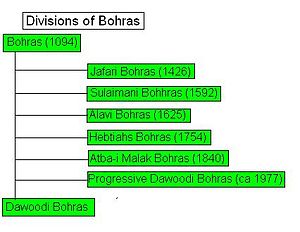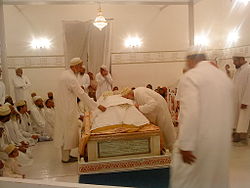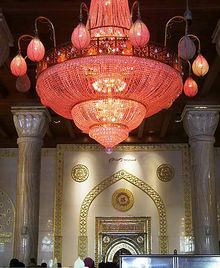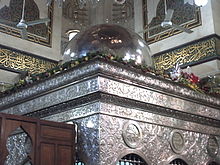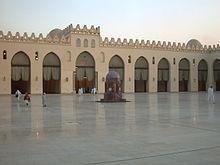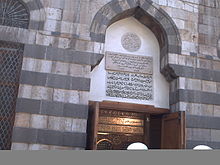- Dawoodi Bohra
-

Part of a series on Shī‘ah Islam Ismāʿīlism 
Concepts The Qur'ān · The Ginans
Reincarnation · Panentheism
Imām · Pir · Dā‘ī l-Muṭlaq
‘Aql · Numerology · Taqiyya
Żāhir · BāṭinSeven Pillars Guardianship · Prayer · Charity
Fasting · Pilgrimage · Struggle
Purity · Profession of FaithHistory Shoaib · Nabi Shu'ayb
Seveners · Qarmatians
Fatimids · Baghdad Manifesto
Hafizi · Taiyabi
Hassan-i Sabbah · Alamut
Sinan · Assassins
Pir Sadardin · Satpanth
Aga Khan · Jama'at Khana
Huraat-ul-Malika · BöszörményEarly Imams Ali · Ḥassan · Ḥusain
as-Sajjad · al-Baqir · aṣ-Ṣādiq
Ismā‘īl · Muḥammad
Abdullah /Wafi
Ahmed / at-Taqī
Husain/ az-Zakī/Rabi · al-Mahdī
al-Qā'im · al-Manṣūr
al-Mu‘izz · al-‘Azīz · al-Ḥākim
az-Zāhir · al-Mustansir · Nizār
al-Musta′lī · al-Amīr · al-QāṣimGroups and Present leaders Nizārī · Aga Khan IV
Dawūdī · Burhanuddin
Sulaimanī · Al-Fakhri Abdullah
Alavī · Ṭayyib Ziyā'u d-DīnDawoodi Bohra ( Arabic/Urdu: داؤدی بوہرہ) is a subsect of Ismāʿīlī Shīʿa Islām. While the Dawoodi Bohra is based in India, their belief system originates in Yemen, where it evolved from the Fatimid Caliphate and where they were persecuted due to their differences from mainstream Sunni Islam. This prompted the shift of Dawoodi Bohras to India.
After occultation of their 21st Imam Tayyib, they follows Dai as representative of Imam which are continued till date. The word Bohra itself comes from the Gujarati word vehwahar ( "trading"), while the term Dawoodi refers to their support for Dawood Bin Qutubshah in the 1592 Dai dispute which divided the Tayyibi sect, creating the Dawoodi Bohra.
They have a very small, tight-knit community made up of approximately one million adherents worldwide, with the majority of adherents residing in India. There is also a large community in Karachi, Sindh. There is also a significant diaspora population in the Middle East, Europe, North America and the Far East.
Dawoodi Bohras have a blend of cultures, including Yemeni, Egyptian, African, and Indian. In addition to the local languages, the Dawoodi Bohras have their own language called Lisānu l-Dā‘wat ("language of the Dā‘wat") which is written in Perso-Arabic script and is derived from Urdu, Gujarati and Persian. The Dawoodi Bohra community is known worldwide for their various projects, including philanthropic efforts, hospitals, schools, and renovations and restorations of Islamic and Shi'a Islamic landmarks.
The spiritual leader of the Dawoodi Bohra community is the Dāʿī l-Muṭlaq (Arabic: داعي المطلق "Unrestricted Missionary"), currently Mohammed Burhanuddin. The Dai serves as the earthly representative of the Imam, currently believed to be occultation.
Contents
History
Main article: Shia Islam
As Shi'as, Bohras believe that their Imāms are descendants of Muhammad by way of his daughter Fatima and her husband Ali. They believe that Muhammad chose Ali as his successor while he was returning from his first and last Haj(year 632AD), when he stopped at Ghadir Khumm. While raising Ali's hand in his, Mohammad declared: "For whoever I had been his moula (leader), now this Ali shall be his moula." This is regarded as proof of instituting Ali as his successor (wasi). A tree depicting the branching of Shi'a Islam from the Dawoodi Bohra perspective
A tree depicting the branching of Shi'a Islam from the Dawoodi Bohra perspective
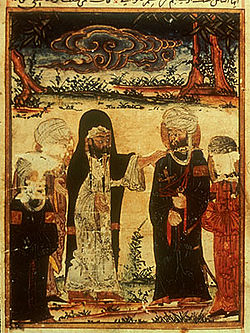 The Investiture of Ali at Ghadir Khumm (MS Arab 161, fol. 162r, AD 1309/8 Ilkhanate manuscript illustration)
The Investiture of Ali at Ghadir Khumm (MS Arab 161, fol. 162r, AD 1309/8 Ilkhanate manuscript illustration)
Dawoodi Bohra as Shi'a believe that after Muhammad, Ali had been the rightful wasi, Imam and khalifa, but the actual zahiri ("literalist") caliphate was usurped by other successors, whom the Sunnis accept. However, during 656 to 661 CE, Ali served as the Caliph; the Imamate and Caliphate were united in this period. After Ali, his son Hasan ibn Ali, the first Imam, struggled for the Caliphate, which resulted in a pact with the Umayyad caliph, Muawiyah I to recognise Muawiyah as Caliph in order to avoid bloodshed, while Hasan retained the Imamate.
After Hasan, Husayn sacrificed himself, his family and companions in Karbala but not agreed to abide Yazid, son of Muawiyah. After the battle of Karbala, Husayn's body was buried near the site of his death. Dawoodi Bohra believe that Husain's head was buried first, in the courtyard of Yazid (the Umayyad Mosque), then transferred from Damascus to Ashkelon,[1] and then to Cairo.[2]
Shia schisms and the Fatimid Dynasty
Main article: IsmailismThe first through the fifth Imam, who was Ja'far al-Sadiq, are common accepted by all the Shi'a. Bohras count Hasan as the first Imam, whereas Nizari Ismailis and Twelvers number Ali as the first. The followers of his son, Isma'il ibn Jafar, became Ismailis, from whom the Bohra descend. Some Shi'a sects such as the Twelvers believe that Musa al-Kadhim was heir to Ja'far instead and that their line diverged at that point. After the death of the Jafar, the Abbasid Caliphate replaced the Ummayad Caliphate, and began to aggressively oppose the belief in the Imamate. Due to strong suppression by the Abbasids, the 7th Ismaili Imam, Muhammad ibn Ismail, went into a period of Occultation. During this period his representative, the Dai, maintained the community.
The names of the 8th, 9th, and 10th Imams are considered by some traditions to be "hidden", and known only by their nicknames due to threats from the Abbasid caliphate. However the Dawoodi Bohra in their religious text, Taqqarub, claim to have the true names of all 21 imams in sequence including those "hidden" imams: 8th Imam Ahmad al-Wafi, 9th Imam Muhammad at-Taqi, and the 10th Imam, Rabi Abdullah.[3][4]
The 11th Imam, Ubayd Allah al-Mahdi Billah founded the Fatimid Caliphate in 909 CE in Ifriqiya (present Tunisia), ending the Occultation. In Ismaili eyes this act again united the Imamate and the Caliphate in one person. The Fatimids then extended up to the central Maghreb (now Morocco, Algeria, Libya). They entered and conquered Egypt in 969 CE during the reign of the 14th Imam Al-Muizz Lideenillah, and made Cairo their capital. After the 18th Imam, Ma'ad al-Mustansir Billah, the Nizari sect believed that his son Nizar was his successor, while another branch, to be known as the Mustaali (from whom the Dawoodi Bohra would eventually descend), supported his other son, al-Musta'li. The Fatimid dynasty continued with al-Musta'li as both Imam and Caliph, and that joint position held until the 20th Imam, al-Amir bi-Ahkami l-Lah (1132CE).
Tayyibi-Hafizi schism
Main article: MustaaliAt the death of Imam Amir, one branch of the Mustaali faith claimed that he had transferred the imamate to his son at-Tayyib Abi l-Qasim, who was then two years old. Another faction claimed Amir died without producing an heir, and supported Amir's cousin al-Hafiz as both the rightful Caliph and Imam. The al-Hafiz faction became the Hafizi Ismailis, who were later eliminated during the rule of Saladin. The supporters of Tayyeb became the Tayyibi Ismailis.
Tayyeb's claim to the imamate was endorsed by the Hurrat ul Maleka,[clarification needed] Arwa al-Sulayhi, the Queen of Yemen. Arwa was designated a hujja,[clarification needed] the highest rank in the Yemeni Dawat, by Al-Mustansir in 1084 CE, and was the first woman to hold that position. Under Queen Arwa, the Dai al-Balagh (intermediary between the Imam in Cairo and local(Yemeni and associate)headquarters) Lamak ibn Malik and then Dai Yahya ibn Lamak worked for the cause of the Fatimid.[clarification needed]
Tayyibis (which include the modern Dawoodi Bohra) believe the second and current period of satr began after Imam Tayyeb went into occultation, and Queen Arwa created the office of the Dai-ul-Mutlaque to administer the community in the Imam's absence. Zoeb bin Moosa (d.546 AH/1151 AD) was the first Dai-ul-Mutlaq, and lived and died in Haus, Yemen. His ma'dhūn (assistant) was Khattab bin Hasan. The 3rd Dai Sayedna Hatim (d. 1191 AD) was prominent among the Du'at of Yemen and wrote many books, both exoteric and esoteric in philosophy on the Ismaili faith.
Establishment in India
Representatives of the Du'at like Moulai Abdullah (460 AH/1067 AD), the first Wali-ul-Hind ("representative in India") and Moulai Ahmed were sent to Khambhat, Gujarat, western India, and the Tayyibi community was established in Gujarat in the second half of the 11th century. Moulai Nuruddin (467 AH) was sent to Deccan. Per legend, while he was there two travellers from India went to the court of Imam Mustansir. They were so impressed that they converted and went back to preach. One of them was Rupnath, whose new name was Maulai Nuruddin; his dargah is at Don Gaon, Maharashtra.The another was Moulai Abadullah (formerly known as Baalam Nath).[5]
Upon arriving in Khambhat, Abdullah came across a married couple named Kaka Akela and Kaki Akela. They became his first converts. A well on their farm had dried up, but Abdullah performed a miracle and the well filled with water. Amazed by this, the couple became the first to accept Fatimid Islam in India, and thus the earliest Bohra.
 Mausoleum of Moulai Hasan Feer, Denmal, Gujrat,India, era 1300-1400 AD
Mausoleum of Moulai Hasan Feer, Denmal, Gujrat,India, era 1300-1400 AD
After the death of Maulai Abadullah, Dai Zoeb appointed Maulai Yaqoob as the second wali in India of the Fatimid dawat, the first such wali of Indian descent. He was son of Moulai Bharmal, minister of Rajput king Siddhraja Jaya Singha (Anhalwara, Patan) (487-527 AH/1094-1133 AD). The king sent his soldiers to get Abadullah, but they could not reach him as they saw a wall of fire created around him. The king himself went to Abadullah and was so impressed with his thoughts that he, along with his ministers Moulai Bharmal and Tarmal and their fellow citizens freely accepted Islam and the Imam.[citation needed] Moulai Fakhruddin, son of Tarmal was sent to western Rajasthan, India for proselytizing. Fakhruddin was killed in Galiyakot, Rajasthan by aboriginal highwaymen (bhil) while returning from Muharram lectures on the martyrdom of Imam Husein.
In the generation of Moulai Yaqoob, Moulais Ishaq, Ali, and Hasan Fir continued one after another as Wali-ul-Hind. Hasan Fir Shaeed was the fifth wali in the era of 16th Dai Abadullah (d. 809AH/1406 AD) of Yemen.
Transfer of Dawat to India
 Ahmedabad, Indian Dai era 1567 AD-1657 AD
Ahmedabad, Indian Dai era 1567 AD-1657 AD
One Dai succeeded another until the 23rd Dai in Yemen. In India also Wali-ul-Hind were appointed by them one after another until Wali-ul-Hind Moulai Jafer, Moulai Abdul Wahab and Moulai Qasim Khan bin Hasan (11th and last Wali-ul-Hind, d.950AH, Ahmedabad). The last three wali were of great help in the era of the 21st to 24th Dai. It was during this time when the Dawat was transferred to India from Yemen, that the 23rd Dai-al-Mutlaq Mohammed Ezzuddin performed nass (transfer of authority) on Yusuf Najmuddin ibn Sulaiman of Sidhpur, Gujrat, India.
Due to persecution by the local Zaydi Shi'a ruler in Yemen, the 24th Dai, Yusuf Najmuddin bin Sulayman (d.1567 AD), shifted the whole administration of the Dawat (mission) to India but continued to live in Yemen and died there. The 25th Dai Jalal Shamshuddin (d.1567 AD) was first dai to die in India; his mausoleum is in Ahmedabad, India. Dai Jalal's tenure as Dai was very short, only a few months, but before that he was Wali-ul Hind (after Moulai Qasim) for about 20 years under 24th Dai Yusuf while the Dai was in Yemen.
Inter-Bohra schisms
Following the death of the 26th Dai in 1591 CE, there was a dispute as to who was to succeed him. Suleman bin Hasan, the grandson of 24th Dai, was wali in Yemen and claimed the succession, supported by the other Yemeni Bohra. However, the Indian Bohra denied his claim of nass, declaring supporting documentation to be forged. The two factions separated, with the followers of Suleman becoming the Sulemani Bohras, and the followers of Dawood Bin Qutubshah becoming the Dawoodi Bohra.
Again in the period of the 29th Dai Abduttayyeb Zakiuddin, a small group of Aliya Bohra separated under Ali bin Ibrahim (1034 AH/1634 AD), the grandson of 28th Dai Sheikh Adam Safiyuddin. A further branch broke from the Dawoodi in 1754, with the Hebtiahs Bohra splicing in a dispute following the death of the 39th Dai.
In the mid-20th century (1970–80), there was another, purely political, fragmentation, as a group of Bohra who stated that the 52nd Dai had overstepped his authority severed from the hierarchy to form the Progressive Dawoodi Bohra.
Persecution in India, and movement of the Dawat
 Mausoleum of Dais of Surat, era 1787-1915 AD
Mausoleum of Dais of Surat, era 1787-1915 AD
In India the Bohras were persecuted by the Mughal rulers. The 32nd Dai Qutubuddin Shaheed was prosecuted and beheaded in 1648 AD under Aurangzeb.
 Mausoleum Dai jam Nagar, era 1657-1738 AD
Mausoleum Dai jam Nagar, era 1657-1738 AD
The 34th Dai Ismail Badruddin (son of Moulai Raj, 1657 AD onward) was the first Dai of Indian Gujrati origin. He shifted the Dawat from Ahmedabad to Jamnagar.[6] During this period Dai also moved to Mandvi and later to Burhanpur. In the era of 42nd Dai Yusuf Najmuddin (1787 AD onward) the Dawat office shifted to Surat. The educational institute Al-Daarus-Saifee (later renamed Al Jamea tus Saifiyah) was built in that era by the 43rd Dai Abdeali Saifuddin, who has done extensive work in the literary field also. During the period of 51st Dai Taher Saifuddin (1915-1965 AD), the Dawoodi Bohra Dawat shifted to Mumbai and continues there to the present day, currently headed by 52nd Dai Mohammad Burhanuddin.
Expansion and recognition
The first Dawoodi Bohra mosque in the West was built in Farmington Hills, Michigan in 1988. Immediately thereafter, the first Canadian masjid was inaugurated by Dr.Sayedna Mohammed Burhanuddin in Toronto. Mohammed Burhanuddin inaugurated the Houston masjid in 1996, which is now being reconstructed into a larger masjid that is four times the original one.
In June 2001 Masjid-ul-Badri in Chicago was inaugurated. In July 2004 new mosques in New Jersey (Masjiduz-Zainy), Washington DC and Boston were inaugurated.[7]
The following year, August 2005, the Dā‘ī l-Mutlaq inaugurated another new masjid in Fremont, California (metropolitan San Francisco) and was congratulated by various officials and dignitaries from local, state and federal US governments. President George W. Bush also sent a letter from the White House.[8] On July 8, 2007, Mohammad Burhanuddin inaugurated a new masjid in Paris, France.[9]
The Prince of Wales and The Duchess of Cornwall visited the Dawoodi Bohra Mosque in London in 2009, and their web page recognise the Bohra as a "community that has made a major contribution to British business and has patriotism at the heart of its faith".[10]
Present activities
While most Dawoodi Bohras have traditionally been traders, currently many are professionals. Within South Asia many are doctors, and in the Far East and the West, a large number now work as consultants or analysts, as well as medical professionals. Dawoodi Bohras are encouraged to educate themselves in both religious and secular knowledge, and as a result, the number of professionals in the community is rapidly increasing.
Dawoodi Bohra believe that the education of women is equally important to that of men, per a hadith from Muhammad: "seeking of knowledge is obligatory for all Muslims, both male and female."[citation needed] Many Dawoodi Bohra women choose to enter the workforce. The founding of Al Jamea tus Saifiyah, an Arabic Academy for Dawoodi Bohras in Surat and Karachi, is a sign of the importance of education in the Dawoodi Bohra community. The Academy's curriculum encompasses religious and secular education for both men and women.
As it is for other Shia Muslims, remembrance of the martyrdom of the Imam Husayn, in Karbala, Iraq, is an essential part of every Dawoodi Bohra community activity. Every year, the head of the Dawoodi Bohra community delivers religious discourses for ten days during Muharram, Ashara Mubaraka|‘Āshārā, culminating in the 10th day of Muharram, ‘Āshūrā, and these are attended by a large number of community members. The martyrdom of Hussain is remembered with every prayer every day[when?] and all the attendees perform matam (beatings of their chests);[citation needed] matam is specially practiced in the month of Moharram and, also in other Islamic months in other Shia sects.
Education and renovation projects
The Dawoodi Bohras originated from Fatimid Egypt, and their cultural mores are based on the practices of the Fatimid Imāms of North Africa - 10th to 12th Century CE - from Tunisia to Cairo, Egypt. Al-Quaed Johar, commander of the Fatimid army under the guidance of Imam Moiz, founded the city of Cairo and built Al-Azhar Mosque. Imam Al-Aziz established the first al-Azhar University in the world, dedicated to religious studies and other faculties including science, mathematics, astronomy, chemistry, and Islamic jurisprudence of the time.[citation needed] The Fatimid influence is also found in buildings and architecture created by Dawoodi Bohras around the world today, all of which mirror the architectural features of the mosques and buildings of Cairo.
 Al Jamea-tus-Saifiyah
Al Jamea-tus-Saifiyah
Al Jamea tus Saifiyah is an Islamic Arabic Academy in the heart of Surat, India and is a leading theological university for Dawoodi Bohras. It was founded in 1814 by the 43rd Dai Abdeali Saifuddin. In 1920, Taher Saifuddin transformed this institution into a university that also promoted education for Bohra women. Under the present Dai, the university has seen a significant expansion and now has an International Baccalaureate Office (IBO). Students from all over the world are admitted here post-VII standard and are taught economics, politics, cultural tradition, philosophy and other subjects in English as well as Arabic.
52nd Dai His Holiness Syedna Mohammed Burhanuddin (T.U.S) undertook the complete renovation and restoration of the Masjid of Imām al-Hakīm in Cairo. The site was destroyed by Napoleon, who used is as a horse stable, and was a project UNESCO had considered and initiated but abandoned, calling it "an impossible task". Some of the most important Fatimid-era mosques were also renovated by the Dai in Cairo as a tribute to the legacy of the Fatimid Imams, including, Masjid Luluwa, Jāmiʻ al-Aqmar (built in 1125)[11] and Jāmiʻ al-Juyūshī in Cairo.[12][13]
 Kufa masjid
Kufa masjid
Mohammad Burhanuddin renovated the Masjid al-‘Azam in Kūfa, Iraq, a place of historical significance in both the Islamic and the Pre-Islamic era. The mosque is also particularly significant to the Shi'a as the place of martyrdom of Ali. Another significant contribution in Iraq is the renovation of the shrines of Husayn in Karbala and that of ‘Alī in Najaf.
In June 2005, the Dawoodi Bohra community built Saifee Hospital in Mumbai, India. The hospital is one of the most technologically advanced hospitals in the entire country, and was inaugurated by the Prime Minister of India, Dr. Manmohan Singh on June 4, 2005. At the inauguration, the Dawoodi Bohra community was commended by the Prime Minister during a speech delivered by him.[14] The hospital was built on the land donated by the well known philanthropist Sir Adamji Peerbhoy.
Dawoodi Bohra 52nd Dai Mohammad Burhanuddin has also been involved with several other notable projects of Shi'a Islam including:
- The gold plating of Maulana Ali's Zaree in Najaf.
- The gold plating of Maulana Abbas e Alamdaar's Zaree in Karbala.
- The construction of Rasul Husain(Cairo)Zarih in Egypt.
- The Mukalafat-al-Rasool next to Hussain, where some of the Imams are buried.
- The construction of Maulatena Zainab's Zaree in Egypt.
- The renovation of the masqurah (masoleum) of Hussain
Burhanuddin, who is known as Manṣūrul-Yaman, has turned his particular attention to his followers in Yemen. Under his reign, his followers in Yemen constructed the mausoleum of Sayedna Hatim and a mosque in Hutaib Mubarak. He also undertook projects for providing water and electricity to the faiz(boarding and lodging facility for pilgrims) and town, and to make the roads to ziyarats in Yemen more accessible.
Dress Code
Ordinary Bohras are highly conscious of their identities; this is especially demonstrated at religious and traditional occasions by the appearance and attire of the participants. Dawoodi Bohra men wear a traditional white three piece outfit, plus a white and gold cap (called a topi), and women wear the rida, a distinctive form of the commonly known burqa which is distinguished from other forms of the veil due to it often being in color and decorated with patterns and lace. The rida additionally differs from the burqa in that the rida does not call for covering of women's faces like the traditional veil. It has a flap called the 'pardi' that usually hangs on the back like the hood of a jacket but it is not used to conceal the face.
Other
Dawoodi Bohra have faith in the Dai and commonly ask his opinion and permission when it comes to their profession.
Men and women are encouraged to follow dress codes which include not cutting beards and keeping the hair short. The dress code is supposed to be strictly followed for all social and religious occasions. Ladies' dress code (wearing 'Rida') is meant to be followed at all times when they leave the house to go to school, bazar or business and jobs. For the man dress code is not felt necessary for other places but to wear typical Bohra headgear('Topi') is encouraged.
Religion
For an overview of the Mustaali Shi'a faith, see Mustaali.The Dawoodi Bohras follow the Seven pillars of Ismaili Islam in the tradition of Fatimid Dawat: Walayah (guardianship of the faith), Taharah (purity), Salah (prayer), Zakat (tithing), Sawm (fasting), Hajj (pilgrimage to Mecca), and Jihad (struggle).
 Mausoleum of 6 th Wali -ul- Hind Moulai Adam,Ahmedabad,d.836AH/ 1433AD
Mausoleum of 6 th Wali -ul- Hind Moulai Adam,Ahmedabad,d.836AH/ 1433AD
Dawoodi Bohra believes Walaya(t) as the most important of the seven pillars of Islam. It is the love and devotion for Allah, through their Dai, Imam, ‘Wasi’(Wali) Ali and Nabi Muhammad.
There is an incident famous amongst Bohra which confirm how they mean and weigh ‘walayat’ principle. There was a ‘Farman’ (order) from 19th Dai Syedna Idris to Wali-ul-Hind (6th) Moulai Adam that he has to follow a person named by "Sakka" (a very pious person but a ‘Bhisti’ (water carrier) by profession, who has accepted Fatemid Dawat but new to its tradition). Everyone was surprised but they did not have any doubt in their mind and prepared "Sakka" ready to perform namaz /prayer, and Moulai Adam along with his associate performed namaz under "Sakka" (Actually there was a second ‘farman’/order to be open after few hours of the first, cancelling the first one and appointing back, Moulai Adam as Wali).
It is further narrated that when Dai Syedna Idris learnt that his orders had been accepted in this way, he was extremely pleased with 'Ikhlaas' (faith) and 'walayat' of the Indian Fatimid. Syedna Idris called all the ‘Hudud'(the noted pious personnel) of Yemen and told them about the incident and forecasted the possibility of relocating the Dawat to India.[15]
Sawm, Hajj and Jihad are believed as all other Islam but their Salah and Zakat have some specific points as below.
Salat (Prayer) as per tradition to be performed five time intervals specified as Fazr, Zohr, Ashr, Magrib and Ishah. Zohr and Ashr are having overlapping period , same is Magrib and Ishah. Hence they are combined together and Bohra perform these five Salat in three intervals. Fazr in morning, Zohr & Ashr in afternoon, and Maghrib & Ishah in the evening, making convenient to perform.
Zakah is done during Month of Ramzaan. This is organized and collected by central authority Dawat–e-Hadiyah in such a fashion through each town head that no Bohra is left out.
The Dawoodi Bohra utilise the versions of the azaan (call to prayer) and shahada common to other Mustaali (may refer), which incorporate mention of Ali,described here also in short.
Kalema-tut-shahadat(Profession of Faith)
As is the case with the majority of Shi'a Muslims, the followers of the Fatimid school append Aliyun waliallah (Ali is the care taker/ friend of Allah) to their Profession of Faith (kalema‐tut‐ sahadat). This modified phrase has been attested as far back as the Fatimid period.[citation needed]
Mustaalis/Dawoodi Bohra recite the kalema thus:
“ La-ilaha illal-laha,Mohammad-an Rasululah wa Ali-un –vali-ullah. "I bear witness that there is no God but Allah, and I bear witness that Mohammad is Allah's servant and His Messenger and Ali is his successor ’vali’ and minister ‘vazir’"
”  photo of qiblah of imam Mustansir in Fatemid masjid of Cairo showing Kalema-tut-shahadat with Aliyun waliallah
photo of qiblah of imam Mustansir in Fatemid masjid of Cairo showing Kalema-tut-shahadat with Aliyun waliallah
 photo of kalema with Aliyun waliallah at Bab al-Nasr Fatimid Cairo
photo of kalema with Aliyun waliallah at Bab al-Nasr Fatimid Cairo
This is right from Fatemi Imam’s era.In one of the Qiblah of Imam Mustansir of Fatemi era masjid of Qahira (Mosque of Ibn Tulun) engraved his name and “kalema‐tut‐sahadat" as ‘La ‐ilah‐ ilal‐lah, Mohamad‐un‐ rasul‐al‐lah Ali –un‐ vali ‐ ul –lah’. The same Kalema exist at Gate Bab al-Nasr built by minister Badr-al-Jamali at northern wall of Fatimid Cairo(Photos placed right).
The third phrase “Ali-un- vali-ul-lah” ,means “Ali is his(Mohammad’s) “Wali" ,"vasi" , the real care taker, stressing the need that for continuation of faith there is requirement of “Wali” , which is one and only “Imam after Imam ” ,which are really taking care of Islam, hence this is also known as the confession of "Imamat".
Kalema –tut-Shahadat make three Islamic teaching "Tauhid", "Nabuwat" and "Imamate" together. In this devotion to god, his Nabi Mohammad and Imam are so linked together that these can not be viewed separately. One leads to other and finally to God the "Allah" almighty.
Shia/Fatimid/Ismaili/Dawoodi bohra's thinking is exactly on same line. Their further downward delegation system explained above from down the Dai fulfill 'Imamate' principle.
Azaan
According to Fatimid/Ismaili/Dawoodi Bohra Ashhadu ana Moulana Aliyan waliullah ("I testify that Ali is the vicegerent of God ") is part of Azaan (but not of iqamah) and they recite it twice after third part of the Azaan. namely 'Ash-hadu anna Muhammadan-rasūlu llāh'
They also recite"Muhammadun -va- Ali-un khayr-ul- bashar va itrat-o- homa khayr-ul-itar " (Mohammad and Ali are the greatest of all men and their descendants are the greatest of all progenies ) twice after 7th part "Hayya 'ala-khayril-amal". This is continued from the time of the Aimmat Fatimiyyeen (In the Iqama(h)t they recite 'Qad qamatis Salat" in place of this).
Also ’Hayya ala khairil amal’ which had been dropped from the Azaan since after Rasulullah, is prayed, loud and clear, according to Nabi's sunnat.
Caliphate and Imamate
On the view of Caliphate, Dawoodi Bohra strongly believe in the Imamate principle (as do other Shi'a groups) of nass as done by earlier Imams mentioned above, and think that the Imam need not be ruler, and he is only to safeguard divine authority of God the din from politics of the world (duniya, the "external World"). As evidence of the continuity of the Imamate, the Dawoodi cite the example of the 3rd Imam, Ali ibn Husayn, who was not killed by the army of Yezid in the Battle of Karbala, claiming that even Yezid could not kill the only surviving male of the Imamate line.[citation needed]
Similarly, the Dawoodi cite the miraculous survival of their 33rd Dai, Syedna Feerkhan Shujauddin, who was arrested by a Mughul ruler Shah Jahan taken to Lahore, and imprisoned in a stable. When a fire broke out in the area, the stable was miraculously spared and the Dai survived. The Moghul ruler was impressed, and believed this was testament to the Dai's holy status, and released him and sent him to Ahmedabad with full honors.[16][17]
Dawoodi Bohra believe that the office of Dai al-Mutlaq was instituted as the Imam was in occultation, and imamate principle is to be followed in his absence to hand over the imamate to Imam Tayyab’s heir who will again reappear as Imam. They cite as precedent the case of the 11th Imam Abdillah, who appeared 150 years after the death of the 6th Imam Ismail, while the intervening imams were "hidden".
This delegation system is structured so that in the absence of their Imam, the Dai guides the community on his behalf, and further appointed his nominee right up to grass root level.[clarification needed] An amil[clarification needed] (usually a graduate of the order's institution of higher learning, Al Jamea tus Saifiyah) who leads a local congregation in religious, social, and communal affairs, is sent to each town where a sizable Dawoodi population exists all over the world. Even for a village with just a few Bohra families nominees can be appointed from amongst themselves also. This is to ensure that the Dai's message reaches each individual, and a direct link to God is established. Walayat reaches up to direct root level, an ordinary Bohra think his village representative as representative of his Dai and all figures above linking god. Each town normally have a mosque and an adjoining jamaatkhanah (assembly hall) where socio-religious functions are held. The local organizations which manage these properties and administer the social and religious activities of the local Bohras report directly to the central administration of the Da'i based in Bombay, called al-Dawah al-Hadiyah and close links are maintained for all Bohra all over the world. They feel world as organization of which god is chief and there is clear cut delegation direct upto last person of community. They feel that this help universal brotherhood amongst them, a same culture, same habits of living, togetherness for the cause of Islam and same time dedication to the land they live[10](may like to see a web article in reference list below '...being a dawoodi bohra'[18]) describing Bohra themselves.
Imams and Dais
Main article: List of Ismaili ImamsMain article: List of Dai of Dawoodi BohraAs Mustaali Ismaili Shi'a Muslims, the Dawoodi Bohra believe that the imamate continued until the 21st Imam, Tayyeb ibn Aamir. Following his occultation, the Dai has served as the imam's temporal representatives on earth; the current Dai is Mohammed Burhanuddin 52nd. Successive Imam is still present on the earth guiding the Dai spiritually and will resurface one day.
Dawoodi Bohras believe that the 21st Mustaali Imam, Taiyab abi al-Qasim, is a direct descendant of the Islamic prophet Muhammad through his daughter Fatima Zahra. According to this belief, Ṭayyib Abī l-Qāṣim went into occultation and established the office of the Dā‘ī l-Muṭlaq as the Imām's vicegerent, with full authority to govern the believing community in all matters spiritual and temporal, as well as those of his assistants, the Ma'dhūn (Arabic: مأذون) and Mukāsir (Arabic: مكاسر). During the Imām's seclusion, a Dā‘ī l-Muṭlaq is appointed by his predecessor. The maʾḏūn and mukasir are in turn appointed by the Dā‘ī l-Muṭlaq. A fundamental belief held by the Dawoodi Bohra is that the presence of the secluded Imām is guaranteed by the presence of the Dāʿī l-Muṭlaq. Dr. Mohammed Burhanuddin is the 52nd and current Dāʿī l-Muṭlaq, and has appointed Khuzaima Qutbuddin as his ma'dhūn and Husain Husamuddin as his mukāsir.


Ailing Dai Syedna Burhanuddin appointed his second son Syedi Mufaddal Saifuddin as his successor in June, 2011 during his London stay.[19] [20]
Tabular Islamic calendar
The Dawoodi Bohra, retain the Fatimid-era Tabular Islamic calendar, which they believe matches perfectly with the lunar cycle, not requiring any correction. In this calendar, the lunar year has 354 days. Their odd-numbered months have 30 days and the even-numbered months have 29 days, except in a leap year when the 12th and final month has 30 days. This is in contrast with other Muslim communities, which base the beginnings of specific Islamic months on sightings of the moon, with the naked eye, by religious authorities, which often result in differing opinions as to the occurrence of religiously significant dates, such as the start of Ramadan.[21] Dawoodi Bohra claims that Imam and his representative are the true moon of Islam, and to see or follow him is same as of honoring or seeing the moon.
Religious Tolerance
As per Fatimid tradition Dawoodi Bohra feel themselves inclined to be tolerant toward other religions. Under 15th Imam Aziz (5th Fatimid Egypt calipha) religious tolerance was given lot of importance. One of the Vazir of Imam Aziz was Christian, and high office were held by both Shia and Sunnis. Imam Aziz rebuilt the church of Mercurius near Fustat and encouraged public theological debate between Chief Qazi and Bishops in order that the ideas of their religions could merge.[22] The Bishop's visit in England to Dawoodi Bohra religious place and mutual understanding between them[23] gives the same message.
See also
Further reading
- The Dawoodi Bohras: an anthropological perspective, by Shibani Roy. Published by B.R. Publishing, 1984.
- Bin Hasan, Idris, Uyun al-akhbar (Bin Hasan was the 19th Da'i of the Dawoodi Bohra. This volume is a history of the Ismaili community from its origins up to the 12th century CE., the period of the Fatimid caliphs al-Mustansir (d. 487/1094), the time of Musta‘lian rulers including al-Musta‘li (d. 495/1101) and al-Amir (d. 524/1130), and then the Tayyibi Ismaili community in Yemen.)
- Mullahs on the mainframe: Islam and modernity among the Daudi Bohras, by Jonah Blank. University of Chicago Press, 2001. ISBN 022605676.Excerpts
- A Short History of the Ismailis, By Farhad Daftary
- The Ismaili,their history & Doctrine, By Farhad Daftary
- Medieval Islamic Civilisation,By Joseph W. Meri, Jere l.Bacharach
- Sayyida Hurra: The Isma‘ili Sulayhid Queen of Yemen,By Dr Farhad Daftary
- Cosmology and authority in medieval Ismailism,By Simonetta Calderini
- Religion, learning, and science in the ʻAbbasid period,By M. J. L. Young, John Derek Latham, Robert Bertram Serjeant
References
- ^ Sacred Surprise behind Israel Hospital, Batsheva Sobelmn, special Los Angeles Times
- ^ Brief History of Transfer of the Sacred Head of Hussain ibn Ali, From Damascus to Ashkelon to Qahera By: Qazi Dr. Shaikh Abbas Borhany PhD (USA), NDI, Shahadat al A’alamiyyah (Najaf, Iraq), M.A., LLM (Shariah) Member, Ulama Council of Pakistan, Published in Daily News, Karachi, Pakistan on 03-1-2009, wikepedia encyclopedia, Islam Wiki
- ^ The dua (prayer) "Taqarrub" lists these names amongst the Imams.
- ^ Quarterly Journal of the American University of Beirut, Vol. XXI. Nos. 1 2, Edited by Mahmud Ghul. The Hidden Imams of the Ismailis. Sami N. Makarem. At Ismaili.net
- ^ Historical fact and Inner history (a continuation) from DawoodiBohras.com
- ^ The Ismaili, their history and doctrine by Farhad Daftary. Chapter -Mustalian Ismailism-p.300-310
- ^ Anjuman-E-Burhani - Masjid History
- ^ http://malumaat.com/pics/sanfrancisco1426/letter_from_president_bush_usa.jpg
- ^ http://malumaat.com/akhbar1428/paris/index1.html
- ^ a b TRH visit the Dawoodi Bohra Mosque in London, 4th February 2009. At princeofwales.gov.uk
- ^ "Al Aqmar Masjid". IslamicArchitecture.org. http://www.islamicarchitecture.org/architecture/alaqmarmosque.html
- ^ Saifuddin, Ja'far us Sadiq Mufaddal. Al-Aqmar: A Living Testimony to the Fatemiyeen. Graphico Printing Ltd (published 2000). ISBN 978-0-9539270-0-5
- ^ Saifuddin, Ja'far us Sadiq Mufaddal. Al Juyushi: A vision of the Fatemiyeen. Graphico Printing Ltd (published 2000). ISBN 978-0-9539270-1-2
- ^ http://pmindia.nic.in/hs04jun2k5-1.pdf
- ^ :http://rangwalatravels.com/ahmedabad09.html/
- ^ http://www.thelinksworld.com/ Ahmedabad na Doat Kiram, 33rd Dai Syedna Feer Khan
- ^ http://www.zeninfosys.net/urus/content/33rd-dai-al-mutlaq-syedna-feerkhan-shujauddin-bin-ahmed-bin-malekshah-ra
- ^ http://hikmah.ekhwan.com/index.php/2007/07/16/the-beauty-of-being-a-dawoodi-bohra/
- ^ Successor to Syedna Mohammed Burhanuddin named
- ^ Ailing leader of Dawoodi Bohras names successor
- ^ Muslims disagree on start of Ramadan, Sarasota Herald-Tribune - Sep 23, 2006
- ^ Mullahs on the mainframe: Islam and modernity among the Daudi Bohras, page-29, By Jonah Blank
- ^ http://www.christianmuslimforum.org/index.php/working-together/news/archbishops-visit-to-dawoodi-bohra-mosque
External links
- Mumineen.org, Mumineen.org hosts accurate and authentic content pertaining to the Dawoodi Bohra muslim community. Bohras adhere to the Shia Fatimi tradition of Islam, headed by the 52nd Dai al-Mutlaq, Syedna Mohammed Burhanuddin (tus).
- City of Brass, blog written by a Dawoodi Bohra muslim
- Malumaat.com, a web-portal for the Dawoodi Bohra community
- DawoodiBohra.org, a community web portal and search engine of Dawoodi Bohra sites
Categories:- Dawoodi Bohras
- Muslim communities of India
- Social groups of Pakistan
- Social groups of Sri Lanka
- Muhajir communities
Wikimedia Foundation. 2010.




